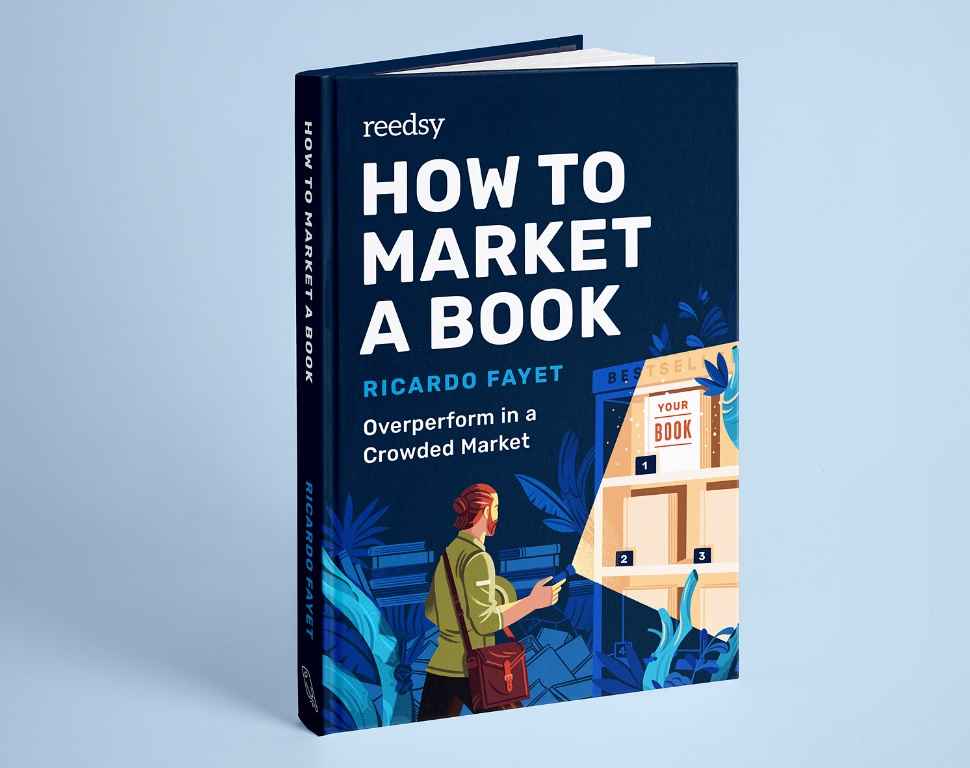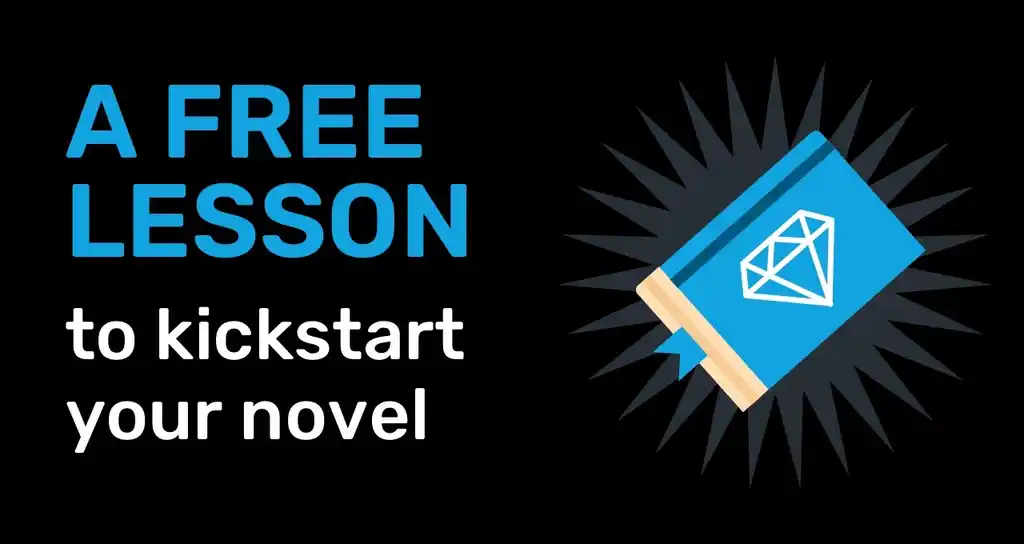Today we're going to be talking about how to plan a successful book launch. So, Instead of the content of our new book How to Market a Book (which can be found for free on all online retailers) I'm going to be talking about the marketing behind how we successfully launched it.
Why did Reedsy write a book?
Before we break it into steps that you can take, the first thing you need to figure out in order to have a successful book launch is what ‘success’ means to you. What are your goals and why did you decide to write your book? In our case, we had three goals:
Reach a new audience through a different channel
The first and main reason we decided to publish a book was to reach a new audience. We have been publishing a lot of blog posts and YouTube videos, as well as offering free learning courses but before this book, we hadn't published a book ourselves. If people were searching for Reedsy on Amazon or any other retailer they couldn’t find anything, which is a bit sad for a company that's in publishing. We wanted to remedy that and access a different channel to increase our visibility.
Bring in new and relevant customers
Related to the first reason, we wanted to get new and relevant customers - the people who either aren’t aware of Reedsy or people who have heard about us but don’t know what we do - to come across the book and find out more about us. So it wasn’t to make money on sales (which is why it’s a free e-book), but to make it easier for those customers to find information about the different services that we offer.
Provide free resources to help authors write, publish and market their books.
As part of our philosophy at Reedsy, we offer a range of free resources - such as courses, events, blog posts, and videos - to help authors publish their books. It just made sense to also release a free book on one of the most complicated topics out there: book marketing.
Marketing and Launching a Book
1. Choose your title(s)
The first step we took when we had the idea to write a book about book marketing was to choose a title. You might think that How To Market A Book is quite unimaginative (someone even told me that it wasn’t a very sexy title), and I absolutely agree. It's not a creative title, but non-fiction titles mainly need to achieve three objectives:
Immediately convey the topic.
Complex titles like Skyrocket Your Presence on Amazon don’t necessarily do that. We wanted to use something very simple and straightforward.
Explain why the book is different from others.
There are other books out there called How To Market A Book. There's a great book by Joanna Penn, for instance, that has the same title which we needed to differentiate ourselves from. We decided to subtitle the book Overperform in a Crowded Market because it addresses the main problem authors face when marketing their books today. There are so many e-books available that you’ll get lost among the competition if you don’t plan your launch well. The subtitle addresses the need to differentiate yourself in a crowded market while explaining exactly what it will teach the reader.
It needs to be optimized for a search.
When I was contemplating different titles, the first thing I did was to run different searches on Amazon for “how to market a book”, “how to promote a book”, “book marketing”, and so on. All the top books had very non-imaginative, simple titles that had the exact keyword I had searched for, or something very similar to it. By titling our book How to Market a Book we achieved our goal of ranking number one on Amazon for the search “how to market a book” in less than a week. As a keyword, it doesn’t necessarily get a high volume of searches - maybe 200 people - but those people will come across our book immediately and learn about Reedsy. That creates some nice organic visibility for us and, at the end of the day, the title fits our goal.
Essentially there are three types of titles that matter for a search:
- Main title
- Subtitle
- Series title.
You can use any of them to try to rank but the main title will generally hold a bit more importance on Amazon these days. The subtitle and the series title would come next, in that order. For some searches you might get away with having the keyword in the subtitle or in the series title, depending on the genre. Series titles are really important for fiction, for instance, where you can get a lot of organic visibility by including the genre in a series title like “Book one in the paranormal witch curse mystery series”.
We focused on the main title because it was the most important in our case. Competing books on the topic had that exact search term in the title, so we didn’t want to try to reinvent the wheel. We would have to use the subtitle instead to add a bit more flourish.
2. Start thinking about the cover.
Ideally, once you have the title you’ll want to design the cover. Your cover design it's going to be your main marketing asset so it’s very important to spend time on it. You want something that is both eye-catching and can be used in newsletters, Facebook ads, and other publicity efforts. Actually, in our case, the cover was the last thing we did but you should be starting your thought process at this point.
Consider the common characteristics of your niche.
We again looked at common titles on the market and immediately noticed one thing they had in common: books about marketing are very, very heavy on typography. The title generally occupies more than a third of the cover so we knew that our cover needed to be very typography-heavy as well. On the top half of the cover we would probably have the title and then at the bottom something that would make us stand out, following the same logic as with the subtitle: using the top of the cover to communicate the most important information, and the bottom to add a creative touch.
Consider illustrations/design ideas once you know what you’re working with.

Our illustrator, Raúl Gil, started drawing some concepts for the bottom bit of the cover, playing with several ideas. One idea was to incorporate all the different aspects of book marketing, such as graphs and mailing lists, placing them around the writer. Another idea was that of overperforming on a crowded market, illustrated by a man climbing a bar chart or an author emerging from a crowd with their book in hand. These were early concepts that we were not 100% sold on but which allowed us to create the first versions of the cover.

The problem is that we didn’t really see the potential to take these concepts further and they didn’t fill the space very well. Raúl thus decided to take things in a completely different direction. In the end, we settled on the idea of me guiding the readers through the jungle of bestseller charts. We liked the idea of the jungle being illuminated by my torch. It felt personal to portray me, the author, partly because some people in the industry know me and a lot of people already receive emails from me with Reedsy insights.
Consider your color scheme.
We played with different colors: one blue which is similar to the Reedsy logo and a darker blue which we went with. The darker blue offered a sharper contrast between me, the books, and the torchlight. It also made us stand out against our competitors in the Amazon charts while, most importantly, making the title easier to read.
Are these tips applicable to fiction as well?
Yeah, some of it is applicable to fiction. The series title can be a way to get some organic visibility for search terms and the cover design is 100% applicable to fiction. You need to spend a lot of time getting the cover design right. Check the covers in your genre and your category on Amazon to see what they have in common. If all of them have a character on the cover, you'll probably want a character on your cover. If all of them have a wolf on the cover, then you're probably writing about werewolves and you're going to want a werewolf on the cover. Try to differentiate yourself in subtle ways (maybe a different palette that's going to catch the eye) while at the same time telling readers, "this is the type of book that you're after; this is a book that you want to read."
3. Choose keywords and categories
This step is focused on Amazon metadata, which is extremely important in order to successfully launch a book. These are decisions you make a long time in advance and shouldn’t be rushed. Keywords and categories impact discoverability in the Kindle Store. When you upload a book to Amazon you can choose two categories and seven keywords. These are going to be used by Amazon to place your book in categories and decide which searches your book will be shown in. In a simplified way, keywords can help increase your organic visibility. This is even more true for non-fiction than for fiction because there's more that you can do with keywords in non-fiction.
What do categories do?
Categories are, in my opinion, a lot more important than keywords, especially for fiction. To thoroughly research categories I used a tool called Publisher Rocket. I mention it quite a few times in the book and it's a tool that I very often recommend for everything related to category research, keyword research, and research for Amazon keywords, as well as Amazon advertising. It lets you see how competitive categories are in bulk by comparing a book’s ranking in a specific category to the overall Amazon store ranking. For example, the book that ranks number one in the entrepreneurship and small business category ranks around 24,500 overall and sells around 11 copies per day. It's not huge but it's something. Another way of putting this is that if you want to get the orange bestseller sticker next to your book when you release it, you know that if you sell 11 copies in one day, you’ll be a bestseller in a low-competition category. Inversely, in the category ‘authorship’ the number one book gets 218 sales a day. To become a bestseller you would need to sell 218 copies a day.
How to make the most out of categories
When uploading a book to Amazon using KDP you can only pick two categories. That doesn’t mean that you’re stuck with these two categories. You can request up to eight additional categories by simply reaching out to KDP support. If you Google KDP support, you click on the first result, and then you click on the first item in the sidebar that says “Amazon product page”. You can then select “request categories”, and send an email to KDP support just to request additional categories. They even have a template within the email that you have to fill with the regional marketplace you want to request the categories for and other details about the book. I did that for both the e-book and the paperback (for both the UK and US marketplace) and in less than 24 hours I was in 10 categories. This can also be done in bulk if you’ve written several books in a series. Make sure you take advantage of this trick as it’s very important for visibility.
How to make the most out of keywords
I did the same research for keywords, using Publisher Rocket to input a bunch of keywords I thought would be relevant for my book. It showed me the number of books that are indexed and trying to rank for each keyword, an estimation of how much an author earns on average for the number-one book of each keyword, an estimation of the number of Amazon searches per month for each keyword, and an estimation of how competitive each keyword is. Based on all that, I decided which seven to pick. Now, the one thing that you need to know about keywords on Amazon, and that's something that not a lot of people know, is that you don’t need to use keywords but are allowed to use keyword phrases. You can put up to 50 characters per keyword box. While “book marketing authors beginners” is not really something that anyone would search for on Amazon, it allows me to index for a range of different keyword combinations using just one keyword box. You basically mix and match all the keywords within one box together. However, you’re going to want to dedicate one or two boxes to an exact keyword (phrase) that you want to rank for because it increases your chances of ranking.
4. Line up some early reviews
After you’ve done your research and written your book, you should try to get some early reviews. This is another thing that we did that was pretty important for our launch. When you release a book, there's nothing worse than if it doesn't sell or get reviews. Sales and reviews go hand in hand and it’s hard to say what comes first. Ultimately, people are not going to take a chance on a book that’s been out for several months and has no reviews. That's why early reviews are important.
I'm lucky to have been working in publishing for six years and to know a lot of people who have been telling me to write a book for a long time. So, I reached out to all my friends and other people in the industry and kindly asked if they would be interested or had the time to have a look since I would love their feedback. I sent an advanced review copy to the people who were interested about a month before the intended launch. A few of them were nice enough to read it and even leave me a cover quote. One from Ben Galley is actually on the paperback cover because it's such a nice quote, and Ben's a long time friend.
You can't expect everyone you reach out to to give you an editorial review. I reached out to maybe 40 or 50 people and I got four editorial reviews so you should cast a relatively wide net. At the same time make sure you don't ask too much of people. I didn't ask them to read and review the book, for instance. Instead, I just told them,
"Hey, here's a complimentary advanced review copy. I know you're busy but if you get a kick out of reading this then I'd love your feedback."
It’s important to network with and ask people (other readers or authors) who are already in your niche because they can offer really good feedback to improve your book before you release it. Feedback is also easier to ask for than a full review, which takes more time and effort. Ideally, you want to foster those relationships early and, back when we could still do that, I would highly recommend going to conferences to meet people in person. Hopefully, in the future, we'll be able to do that again. Forming real relationships with people makes them more inclined to read advanced copies of your books.
Nothing sells your book like a cover quote or editorial review by a well-known name in the genre. If you write a thriller and you get a quote from Lee Child, it’s going to sell like hotcakes. That's very unlikely but maybe you can get an editorial review from very popular indie authors that a lot of readers will be familiar with, like Mark Dawson or Nick Stephenson. It's worth taking the time to build those relationships to get these editorial reviews in.
In our case, we already had a wide readership of our newsletter and didn’t need to send advanced copies to potential customers. Instead, we focused on influencers and partners to get editorial reviews. If you don’t quite have that reach that ensures customer reviews when you launch, you should also send advanced copies to regular readers for reviews.
5. Boost your Amazon Ranking
If you’ve prepared well, using the steps that I’ve already outlined, you don’t need to put too much emphasis on this part. However, there are still some things that you can do, dividing them between the days around your book release, to boost your sales:
Mailing lists
Your mailing list is crucial as it can get you some easy downloads. Building one takes time and effort but it can be an incredibly powerful tool when launching your book. If you’re in non-fiction you probably already have a platform so make sure to leverage it. If you're writing fiction, try to build your platform with a newsletter or mailing list.
Facebook groups
There are a bunch of Facebook groups for every genre where you can cultivate your relationships with partners and influencers. Make sure to join groups in your genre early enough to have time to find the ones where there is real engagement from readers and, crucially, start to engage as a reader yourself. You can mention that you're a prospective author but don’t shamelessly self-promote by spamming about your release day. If you’ve built real relationships, when your launch date arrives, the virtual friends that you’ll have made will probably already be aware that you're launching a book, and they'll post about it for you in the group.
Live events
Live events are another great way to get more reach, especially these days. If you already have a platform, organize a webinar to discuss things surrounding your book and how you’re launching, or do a Q&A, for instance. On top of announcing via a newsletter, this will help get the word out.
Advertising campaigns
To get a plateau of sales, you can also set up ad campaigns on Facebook or other platforms when you’ve exhausted your other channels. This is important if you want to rise high in the Amazon rankings and avoid a drop once the effects of the newsletter and other launch tactics wear off.
Promotions
Finally, promos are probably the oldest marketing tactic in self-publishing but, if your book is not already free like ours, by far one of the most effective. Selling your book at a discounted price for a few days (while you focus on paid ads and continue to get the word out), you can extend your window of visibility. When the price goes back up again, you will get a few full-price sales as a result.
To maximize the effect, split the promotion tactics that I have mentioned up into separate days. It can look like this:
- Day 1: Informing friends and partners and spreading the word in Facebook groups.
- Day 2: Emailing a portion of the mailing list.
- Day 3: Emailing another portion of the mailing list.
- Day 6: Set up ads when the other channels have been exhausted to keep the sales going and announce a promotion via multiple channels.
Thanks to these tactics, our free e-book got to the top 25 on the overall free Kindle store on Amazon and was the number one non-fiction title on the Kindle free store. Right now it's still within the top 200 even though the sales have fallen quite a bit. Importantly, they haven't fallen completely and I managed to get that ranking to stick. Stickiness is really important when marketing and launching your book.
A quick summary of how to plan a successful book launch:
- Make sure that you build your network and mailing list early.
- Make sure to optimize your cover and your title.
- Think about Amazon search engine optimization (especially for non-fiction).
- Choose the right keywords and categories.
- Make the best out of the keyword boxes with long keyword phrases.
- Reach out to KDP support to request more categories after carefully researching them.
- Send out your advance review copies to partners or readers at least a month in advance.
- Finally, book live events to coincide with your launch and focus on promoting your book.






